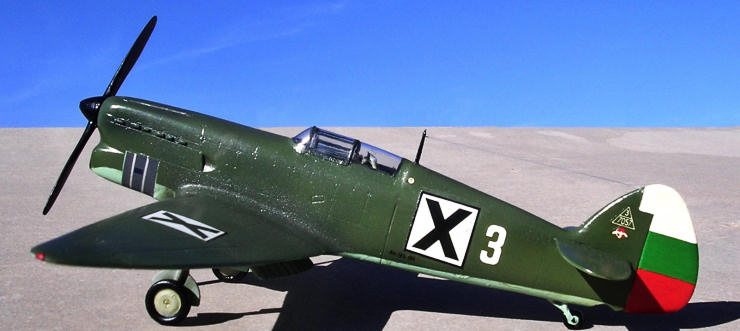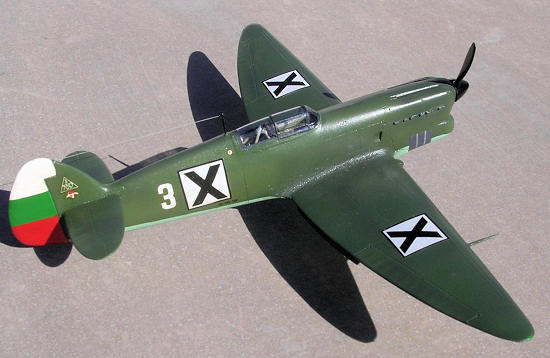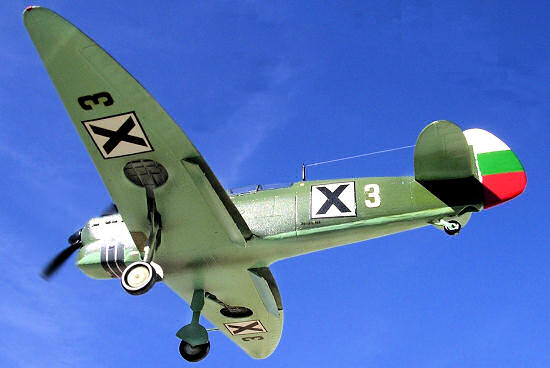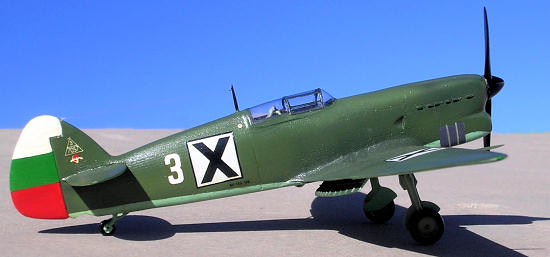1/48 MPM Avia B.135
|
KIT #: |
4802 |
|
PRICE: |
8 Euros |
|
DECALS: |
One option |
|
REVIEWER: |
Carmel J. Attard |
|
NOTES: |
Vacuform with injected parts |

The Avia B-135 was designed and
built by the Avia Company of
Czechoslovakia
during the Second World War. It was a continued development of the Avia B-35/3
single-seat fighter prototype. The B-135 was a cantilever monoplane of mixed
construction. The fuselage had steel framework, the front fuselage was covered
with electron panels, rest with fabric. The wings had straight leading edge with
two spars, wooden ribs and was plywood and aluminium covered. The tail planes
had fabric covering. Pow ered by one Avia (Hispano Suiza) 12Y Vee-engine rated at
890HP, it attained a maximum speed of 332 mph at 13,125 feet and cruising 286
mph at optimum altitude. A new all- metal wing was added to create a new fighter
that received the new designation.
ered by one Avia (Hispano Suiza) 12Y Vee-engine rated at
890HP, it attained a maximum speed of 332 mph at 13,125 feet and cruising 286
mph at optimum altitude. A new all- metal wing was added to create a new fighter
that received the new designation.
The programme of the B-135 began in 1940. The
new type aroused the interest of visiting Bulgarian military mission due to its
excellent flying characteristics. As part of a long-term programme to upgrade
Bulgarian aircraft manufacture, March 1943 saw the delivery of 12 Avia B-135
Lyastovica (Swallow). The order for 12 examples of the B-135 was placed on a
lead-in to Bulgarian licensed manufacture of 50 examples of the type as
DAR-11
at Lovech. The 12 fighters were built in the summer of 1942 and entered service
with the Bulgarian AF’s fighter pilot school. They also saw some operational
service in 1944 and continued to fly for many years.
The B-135 had a service
ceiling of 27,890 Ft and a range of 342 miles. Armament consisted of 20 mm fixed
forward firing cannon and two 7.92 mm forward firing machine guns. At one time
it served with units destined for anti aircraft defence of the city of
Sofia.
On 30th March 1944 four of the fighters were to be flown operationally against
American B-24 bombers which were returning from an attack on the Ploesti oil
fields via Bulgarian air space and one of the bombers was claimed to be shot
down by Lt. Jordan Ferdinandov who was flying one of the Avia fighters. The Avia
B-135 turned out to be underpowered and went to
Dolna
Mitropliya
Fighter
School
to be flown mainly by instructors.
This is one of early MPM scale
models. It comes in a cardboard box with a box art depicting a dark olive drab
B-135 parked at dispersal in a Bulgarian airfield. A vac form kit molded in soft
white acetate, soft and good quality having fine recessed panel lines. Smaller
parts as undercarriage legs, wheels, propeller, cockpit detail parts all come in
injected brown plastic. Cockpit was injected. The only clear part was the
cockpit canopy, in my example it was vac form in very clear acetate.
 Construction starts with sub
assembly of the cockpit office consisting of floor cut from backing sheet,
rudder pedals, pilot seat, control pillar, ‘A’-frame behind seat and instrument
panel. These were assembled and painted. Fuselage and wing halves were cut from
backing sheet and treated in same way as previous vac-form construction manner.
Construction starts with sub
assembly of the cockpit office consisting of floor cut from backing sheet,
rudder pedals, pilot seat, control pillar, ‘A’-frame behind seat and instrument
panel. These were assembled and painted. Fuselage and wing halves were cut from
backing sheet and treated in same way as previous vac-form construction manner.
The area around nose intake
interior was built up making it in form of an enclosed compartment as indicated
in the instruction sheet and the nose exhaust ports drilled open. Undercarriage
leg doors were cut and assembled to the oleos. Some cross frame channels added
to wheel well interiors and flaps, which were assembled in lowered position,
making ref to drawing provided. Practically no problems whatsoever were
encountered and in fact this was a straightforward and quick kit built. The 1/48
scale plans provided proved very useful reference source throughout the
assembly.
 The Bulgarian B-135 serving with
the advanced fighter training school was painted in similar standard green upper
and light blue undersides just like all other trainers serving alongside like
Bu-181, Me-108 and Storch. Some reference of the type shows it in 2-tone green
upper in order to give it a fighter like appearance but this was all speculative
and so I preferred to stick to the instructions. I painted my model in uniform
shade of RLM 71 while the underside was Light blue grey RLM 65. Other items like
the water cooler intake front, cockpit interior, pilot seat, A-bracket framework
behind seat, and part of wheel oleos were all light grey.
Decal sheet proved to be good quality and gave no trouble in spite of its
age.
The Bulgarian B-135 serving with
the advanced fighter training school was painted in similar standard green upper
and light blue undersides just like all other trainers serving alongside like
Bu-181, Me-108 and Storch. Some reference of the type shows it in 2-tone green
upper in order to give it a fighter like appearance but this was all speculative
and so I preferred to stick to the instructions. I painted my model in uniform
shade of RLM 71 while the underside was Light blue grey RLM 65. Other items like
the water cooler intake front, cockpit interior, pilot seat, A-bracket framework
behind seat, and part of wheel oleos were all light grey.
Decal sheet proved to be good quality and gave no trouble in spite of its
age.
This was another enjoyable build
in spite that it was not to the scale that I favour. Certainly an interesting
model to add to anyone’s collection of WWII types.
Carmel
J. Attard
March 2012If you would like your product reviewed fairly and fairly quickly, please contact the editor or see other details in the Note to
Contributors.
Back to the Main Page
Back to the Review
Index Page
Construction starts with sub
assembly of the cockpit office consisting of floor cut from backing sheet,
rudder pedals, pilot seat, control pillar, ‘A’-frame behind seat and instrument
panel. These were assembled and painted. Fuselage and wing halves were cut from
backing sheet and treated in same way as previous vac-form construction manner.
The Bulgarian B-135 serving with
the advanced fighter training school was painted in similar standard green upper
and light blue undersides just like all other trainers serving alongside like
Bu-181, Me-108 and Storch. Some reference of the type shows it in 2-tone green
upper in order to give it a fighter like appearance but this was all speculative
and so I preferred to stick to the instructions. I painted my model in uniform
shade of RLM 71 while the underside was Light blue grey RLM 65. Other items like
the water cooler intake front, cockpit interior, pilot seat, A-bracket framework
behind seat, and part of wheel oleos were all light grey.
Decal sheet proved to be good quality and gave no trouble in spite of its
age.